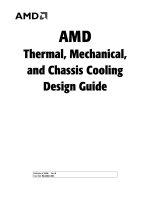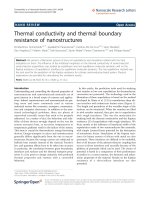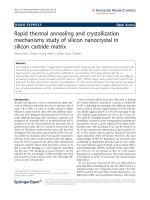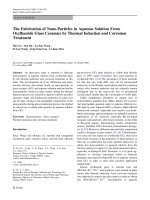Manual heating, thermal cutting and gouging
Bạn đang xem bản rút gọn của tài liệu. Xem và tải ngay bản đầy đủ của tài liệu tại đây (2.88 MB, 64 trang )
5.7A Manual heating,
thermal cutting and gouging
Pictures reproduced with the kind permission of BOC,WIA, ARCAIR Pacific Ltd and Manufacturers Monthly
ATTENTION
It is ILLEGAL to make copies of this presentation.
2001 ARRTS Pty Ltd - All rights reserved.
Purchasers are licensed to make presentations directly from the supplied CD
and to make printed copies for students who attend presentations.
By continuing with this presentation you signify that you agree with the
license conditions and that you are using an original copy of the CD.
NOTE TO LECTURER
This resource is designed to be used as a lecturer support to complement the
Metal and Engineering Industry Competency Standards.
The practical nature of this unit means that these support materials
cannot cover all of the information required for students to meet competency.
Students will be required to demonstrate certain competencies in their
workplace/training organisation.
5.7A Manual heating, thermal cutting and gouging
Range statement
•
•
•
•
•
•
•
•
Work is undertaken autonomously or as part of a team.
Predetermined standards of quality and safety are observed and work is carried
out following standard operating procedures.
Manual, straight line cutting standards observed.
Manual or automatic processes used to cut and heat to specifications.
All work carried out to legislative and regulatory requirements.
Cutting may be applied to material of various thicknesses and types including
ferrous, non-ferrous and non-metallic materials by a variety of methods which
may include oxyacetylene, plasma, carbon arc, thermal lance etc.
Cutting may include use of hand-held and self-propelled straight line cutters.
Heating may be applied to material of various thicknesses and types including
ferrous, non-ferrous and non-metallic materials by a variety of methods which
may include oxyacetylene, oxy/fuel gas, oxy/hydrogen etc.
Element 5.7A.1 Assemble/disassemble plant, equipment for manual
heating, thermal cutting and gouging
In this element you will be required to achieve competency in the
following areas:
1.1 Appropriate cutting process and/or procedure for
material is selected. In this presentation we will look at:
• safety in thermal cutting
• oxy-fuel gas cutting equipment
• distortion control
• plasma arc cutting
• air/arc gouging
• thermal lance and underwater cutting.
1.2 Accessories and equipment correctly selected and
assembled.
Practical - to be carried out in the workplace/training organisation
5.7A Manual heating, thermal cutting and gouging
Safety in thermal cutting
Fumes
Fumes are harmful if breathed in.
Burning gases produce:
• oxides and nitrous gases
– (incomplete combustion or oxidisation of nitrogen from atmosphere).
Caused by:
• Surface coatings fluxes.
• Galvanised coatings.
• Cadmium coatings.
• Chrome coatings.
• Paint and solvents.
• Composition of parent metal.
• Filler rods and fluxes.
Reproduced with the kind permission of
Nederman
5.7A Manual heating, thermal cutting and gouging
fumes
Safety in thermal cutting
• Dust and vapours are given off in welding
processes:
– eg: lead, cadmium, zinc.
They cause:
• gasping or asphyxiation because oxygen has
been depleted
• respiratory ailments from wheeziness and
serious lung disorders.
Always use ventilation where possible, otherwise
use respirators.
Dangerous
5.7A Manual heating, thermal cutting and gouging
Safety in thermal cutting
Heat
•
•
Heat is a form of energy.
When a substance is heated the molecules vibrate or move more rapidly.
TYPES
• CONDUCTION
– Travels through a solid (must have physical contact).
• Copper and AL are good conductors.
• Cast iron and SS are poor conductors they localise heat.
•
RADIATION
– Travels through air by wave motion.
• No physical contact necessary.
• During intensive welding such as pad welding.
•
CONVECTION
– Travels through fluids or air because of the differences in temperature.
5.7A Manual heating, thermal cutting and gouging
Safety in thermal cutting
Hazardous locations
•
•
A hazardous location is an area where flammable or explosive substance are
present or have been.
No oxygen equipment can be taken into these areas unless a permit is obtained
from a safety officer.
HAZARDOUS LOCATIONS
• Alcohol distilleries, oil refineries, paint factories, explosive plants, coal
crushers, flour mills, saw mills, wheat silos, paper mills.
PROCEDURE FOR HAZARDOUS LOCATIONS
• Inform safety officer of work and equipment to be used.
• Officer must inspect site and make safety recommendations.
• Safety officer must issue a work permit.
• When cutting , welding or heating you must know the nearest fire brigade and
phone number.
• Have on hand the correct fire extinguishers.
• Wait 1 hour minimum after you have finished cutting, welding or heating.
5.7A Manual heating, thermal cutting and gouging
Safety in thermal cutting
Safety in a confined space
CONFINED SPACES
• Often cutting is done in confined spaces where both physical
movement and air circulation is limited.
• Tanks, drums, boilers, ships are examples of confined spaces.
SAFETY
•
•
•
•
•
•
•
Have an adequate supply of fresh air.
Keep gas cylinders outside.
Light torches outside.
Keep hoses as short as possible.
Turn equipment off when not being used.
Work with an assistant outside at all times.
Reproduced with the kind permission of BHP Pty Ltd
Have fire fighting equipment on hand at all times.
5.7A Manual heating, thermal cutting and gouging
Safety in thermal cutting
Dangerous containers
•
•
•
•
•
Containers which hold or have held flammables.
Flammables can get into seams.
Don’t rely on sight or smell.
Obtain a chemical analysis.
Obtain a work permit from a safety officer.
CLEANING AND PURGING PROCEDURES
• Steam clean containers for 30 minutes minimum after container is hot.
• Fill container with water and bring to a boil. Boil for 30 minutes
minimum (remove all caps).
• Fill container with water or an inert gas just below weld site and vent
to atmosphere.
• Obtain approval from a safety officer before working on containers
after all of the above.
5.7A Manual heating, thermal cutting and gouging
Safety in thermal cutting
Protective clothing
PROTECTIVE CLOTHING
•
•
•
•
•
•
Overalls (cotton or wool).
Leather gloves.
Leather apron.
Leather spats.
Safety boots.
Oxy Goggles Shade 5 filter lens.
Reproduced with the kind permission of BOC
5.7A Manual heating, thermal cutting and gouging
Safety in thermal cutting
Safety and burns
SAFETY
• Cutting streams shower hot sparks.
• Remove hoses to avoid sparks and falling cut metal.
• Check for leaks in hoses and equipment.
• Close cylinders if not to be used for periods > 15 minutes.
• Remove flammable material from the immediate area.
• Check the location of fire extinguisher in the area before
commencing work.
• Mark work ‘HOT’ if you are leaving the immediate area to
prevent others getting burnt.
Reproduced with the kind permission of Australasian Welding Journal
5.7A Manual heating, thermal cutting and gouging
Oxy fuel gas cutting process
•
•
•
•
FUEL GAS CUTTING
– Requires a chemical action to cut.
– Preheat flame maintains the ignition temperature of plate.
– Preheat flame is maintained at a constant height above plate (a few mm).
PROCESS
– Ignition temperature 8150C.
– Oxidisation of a ferrous metal in an oxygen stream.
– Slag removed by a high pressure oxygen stream.
– Continuous movement of the blowpipe.
SUCCESS DEPENDS ON
– Metal ignition temperature must be below metals melting point.
Reproduced
with the kindmetal.
permission of BOC
– The oxide formed must melt at a lower temperature than
the parent
USES
– Cutting steel in all industries.
5.7A Manual heating, thermal cutting and gouging
Oxy fuel gas cutting
The equipment
Reproduced with the kind permission of BOC
Acetylene Cylinder
Oxygen Regulator
Acetylene Regulator
Oxy Spanner
Oxygen Cylinder
Gas Hoses
Welding Goggles
shade 5 minimum
Leather Gloves
Cylinder Key
Tip Cleaners
Filler Rods
Welding Tips
Torch Handpiece
Flint Lighter
5.7A Manual heating, thermal cutting and gouging
Safety in thermal cutting
The equipment-cylinder handling
OXYGEN SAFETY
•
•
•
•
•
•
Don’t operate pneumatic tools with oxygen.
Don’t use oxygen for spray painting.
Don’t use oxygen instead of compressed air.
Don’t blow out pipelines, vessels or containers with oxygen.
Don’t use oxygen to freshen air.
Don’t dust or blow down clothing with oxygen.
5.7A Manual heating, thermal cutting and gouging
The equipment-oxygen cylinders
Industrial oxygen cylinders come in three (3) sizes
• “G”
“E”
“D”
Filled to 15000 kPa.
They are always colour coded BLACK.
• They have a right hand thread connection.
• They have a bursting disc at the top of the cylinder:
– this will burst if a greater pressure is reached
– never use oil or grease with oxygen
– use BRASS or COPPER joiners if a hose breaks.
Reproduced with the kind permission of BOC
5.7A Manual heating, thermal cutting and gouging
Oxygen
Oxygen Gas (aids combustion)
Oxygen is odourless and colourless.
Industrial gas is produced by liquid air
processes.
• 20% of the atmosphere is oxygen
• 80% of the air is mainly nitrogen
When air is frozen these gases become a liquid.
• In this state they can be easily separated.
• As the temperature rises nitrogen returns to
a gas leaving the oxygen as a liquid:
– nitrogen is tapped off as this occurs.
Reproduced with the kind permission of
Linde Australia Pty Ltd
5.7A Manual heating, thermal cutting and gouging
Safety in thermal cutting
The equipment - cylinder handling
ACETYLENE SAFETY
• Don’t decant or transfer acetylene from one cylinder to another.
• Stand cylinders upright as cylinder contain a porous material
saturated in liquid acetone.
• Leave cylinder keys in cylinders.
• Crack cylinders 1/2 turn only.
• Keep cylinders well ventilated.
• Keep cylinder away from temperatures above 1000C as cylinders
have fusible plugs which will melt and allow acetylene to escape.
• All acetylene cylinders are left hand threads.
• Don’t join connections with copper.
• Don’t use above 15psi or 100kpa.
• ALWAYS ENSURE CYLINDERS ARE SECURED IN A
TROLLEY OR TO A STAND.
5.7A Manual heating, thermal cutting and gouging
The equipment - acetylene cylinders
There is no free gas present in an acetylene cylinder.
The acetylene is dissolved under pressure in acetone.
Cylinders come in three (3) sizes
• “G”“E” “D”
Cylinders are filled to 1600 kPa
They are always colour coded CRIMSON (Maroon)
• They are left hand threaded.
• They have notch on thread joints.
• They are different to LPG threads.
• They have a fusible plug:
– this melts at 100oC.
• Acetylene is very volatile.
• Use BRASS or MILD STEEL if you need to join a hose:
– never use copper.
• Never use oil or grease.
5.7A Manual heating, thermal cutting and gouging
Acetylene
Acetylene (is the fuel gas)
Acetylene is the only gas suitable for fusion welding:
• burns at correct temperature for melting steel
• the flame is least likely to contaminate the weld.
Acetylene is a highly flammable gas:
• it is colourless
• it has a strong odour.
Acetylene is produced by a chemical process.
• It is produced by mixing water and calcium carbide:
– this produces slaked lime and acetylene.
• Stored acetylene is dissolved under pressure in liquid
acetone.
Porous material inside the cylinder is saturated with
acetone to further reduce the risk of explosion when bottled.
5.7A Manual heating, thermal cutting and gouging
Oxy fuel gas cutting
The equipment - regulators
GAS REGULATORS
• A mechanical device fitted to a gas cylinder to:
– reduce pressure in cylinder (high) to gauge pressure (low)
– allow adjustment of working pressures
– maintain a constant working pressure.
Reproduced with the kind permission of BOC
OXYGEN REGULATORS
• Black in colour.
• Right hand threaded.
• Working pressures unlimited.
• Explosion can occur if oxygen and oil or grease come in contact with each
other.
5.7A Manual heating, thermal cutting and gouging
Oxy fuel gas cutting
The equipment - regulators
ACETYLENE REGULATORS
• Maroon, claret in colour.
• Left hand thread.
• Maximum working pressure 100 kPa (15psi).
• Can explode if working pressure above 100kPa (15psi).
• Acetylene gas will react with copper.
Reproduced with the kind permission of BOC
LPG REGULATORS
• As for acetylene.
• Threaded connection on cylinder slightly different to acetylene.
(adaptor is required).
5.7A Manual heating, thermal cutting and gouging
Oxy fuel gas cutting
The equipment - the nozzles
• COMMON CUTTING NOZZLES
The most common nozzles are:
Pre heat holes
– OXYGEN/ACETYLENE
• Type 31, 41, 91.
• They have 5 preheat holes in end of tip.
– OXYGEN/LPG
• Type 34, 44, 94.
• They have a recessed bottom.
• Continuous ring of preheat holes.
Cutting Orifice
5.7A Manual heating, thermal cutting and gouging
Oxy fuel gas cutting
The equipment - nozzles identification
First No. refers to the
type of connection
3x screw in connection
4x taper seat connection
9x flat seated connection
TYPE 41
Cutting Orifice Diameter
15
HS
1.5mm
Last No. refers to the fuel gas
x1 acetylene
x2 low pressure
acetylene
x3 coal gas
x4 LP gas
x5 hydrogen
Uses
HS -High Speed
GB - Gouging Bend
GS - Gouging Straight
UW - Under Water
SM - Sheet Metal









